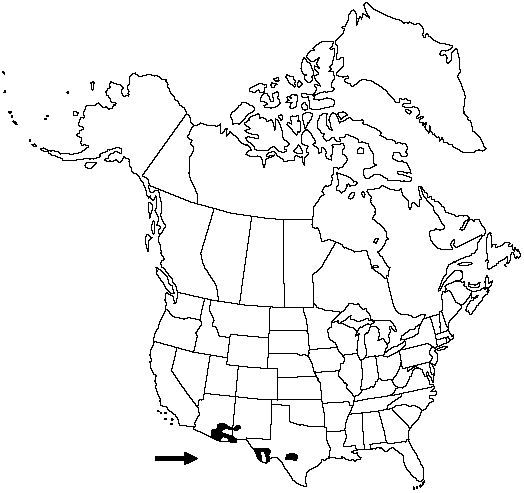Pinus cembroides
Abh. Math.-Phys. Cl. Königl. Bayer. Akad. Wiss. 1: 392. 1832.
Shrubs or trees to 15m; trunk to 0.3m diam., strongly tapering, much branched; crown rounded. Bark red-brown to dark brown, shallowly and irregularly furrowed, ridges broad, scaly. Branches spreading-ascending; twigs red-brown, sometimes finely papillate, aging gray to gray-brown. Buds ovoid to short cylindric, pale red-brown, 0.5–1.2cm, slightly resinous. Leaves (2–)3(–4) per fascicle, spreading to upcurved, persisting 3–4 years, 2–6cm × 0.6–0.9(–1)mm, connivent, 2–3-sided, blue- to gray-green, abaxial surface not conspicuously whitened with stomatal bands or if stomatal bands present, these less conspicuous than on adaxial surfaces, often with 2 subepidermal resin bands evident, adaxial surfaces conspicuously whitened with stomatal lines, margins entire to finely serrulate, apex narrowly conic or subulate; sheath 0.5–0.7cm, scales soon recurved, forming rosette, shed early. Pollen cones ellipsoid, to 10mm, yellow. Seed cones maturing in 2 years, shedding seeds and falling soon thereafter, spreading, symmetric, ovoid before opening, broadly depressed-ovoid to nearly globose when open, 1–3.5cm, pale yellow- to pale red-brown, resinous, nearly sessile or short-stalked; apophyses thickened, slightly domed, angulate, transversely keeled; umbo subcentral, slightly raised to depressed, truncate or umbilicate. Seeds ovoid to obovoid; body (7–)12–15(–20)mm, brown, wingless. 2n =24.
Habitat: Pinyon-juniper woodland, foothills, mesas, tablelands
Elevation: 700–2300m
Distribution

Ariz., N.Mex., Tex., Mexico.
Discussion
Pinus cembroides is the common pinyon of Mexican commerce. Populations of the Edwards Plateau, Texas, are disjunct about 150km east and north of the main area of distribution of the species, and they have been described as a distinct variety, P. cembroides var. remota Little, on the basis of thin seed shell and a higher frequency of 2-leaved fascicles in contrast to the thicker seed shell and prevalently 3-leaved fascicles in Mexican pinyon populations to the west and south. The strong overlap in nearly all character states between the populations of the Edwards Plateau and other populations makes var. remota difficult to maintain.
Selected References
None.